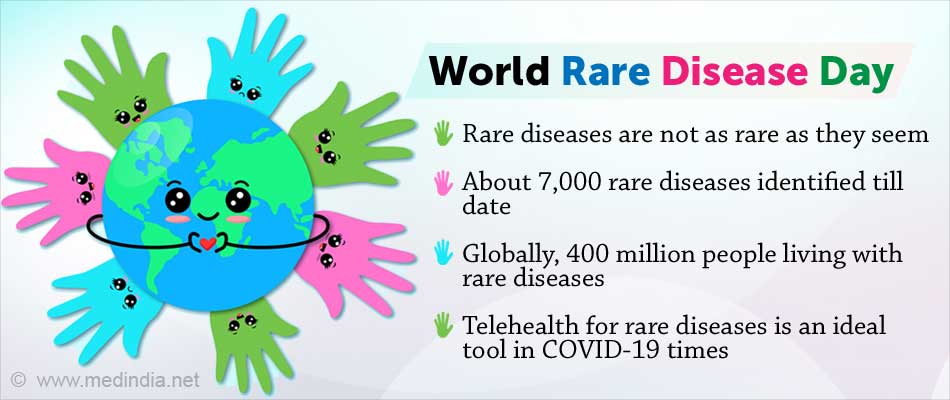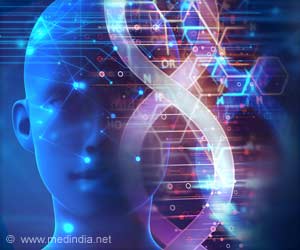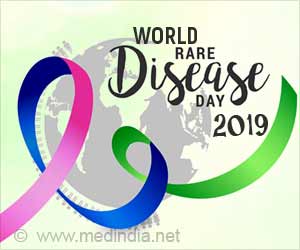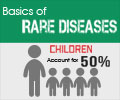
- World Rare Disease Day takes place on the last day of February every year
- Aims to raise awareness among the general public and decision-makers
- The 2021 theme is “Telehealth in Rare Diseases” which stresses on the importance of this novel technology
Read More..
World Rare Disease Day Theme for 2021
“Telehealth in Rare Diseases” is the theme for this year’s celebrations. This theme is very apt, given the fact that telehealth has been instrumental in providing vital health consultations remotely throughout the COVID-19 pandemic. This has allowed patients to access their healthcare providers from the safety of their homes, without the risk of getting infected by the virus by venturing outdoors and coming in contact with potentially infected people.Objective of World Rare Disease Day
The primary objective of World Rare Disease Day is to generate greater awareness about rare diseases among the masses and sensitize policymakers for making legislations that positively impact the lives of those suffering from these devastating diseases. Besides policymakers, it aims to include other stakeholders, including doctors, medical scientists, pharma companies, lawyers, educationists, and public health experts.What is a Rare Disease?
A disease that affects a comparatively fewer number of people than other diseases is termed a rare disease. In Europe, a disease that occurs in less than 1 in 2,000 people is said to be a rare disease. Paradoxically, rare diseases individually affect only a handful of people across the globe, but collectively the number can be formidable, equivalent to the population of the world’s third-largest country or approximately 6-8 percent of the global population.The greatest problem with rare diseases is that they can’t be cured and the treatment is also very costly. Diagnosis is also a challenge, given the large variety of rare diseases and the multitude of symptoms that they exhibit, which overlap with those of other diseases. This often leads to misdiagnosis, which delays treatment considerably. Moreover, some types of rare diseases can even be fatal.
Rare Diseases: Facts & Figures
The statistics for rare diseases, at the global and national levels, are presented below:Global Statistics:
- 7,000 rare diseases exist today worldwide
- 400 million people globally are affected by a rare disease
- Rare diseases impact more people than AIDS and cancer combined
- 3.5 – 5.9 percent of the global population is affected by rare diseases
- 1 in 10 people are affected by a rare disease
- 65 percent of rare diseases are associated with a reduced lifespan
- 3 - 10 percent of hospitalizations are related to a rare disease
- 50 percent of rare diseases occur in children
- 3 in 10 children with a rare disease die before the age of 5 years
- 28 percent of neonatal ICU deaths are caused by a rare disease
- 72 percent of rare diseases have a genetic cause
- 28 percent have other causes (infections, allergies, and environmental factors)
- 70 percent of genetic rare diseases begin in childhood
- It takes over 8 years for a rare disease to get diagnosed accurately
- 95 percent of rare diseases don’t have an USFDA-approved treatment
- 72-96 million Indians are affected by rare diseases
- 450 rare diseases have been reported from India so far
- 1 in 20 Indians suffer from a rare disease
Top 10 Rare Diseases in India
The top 10 most common rare diseases in India are listed below:- Hemophilia
- Sickle-cell anemia
- Thalassemia
- Primary immunodeficiency in children
- Autoimmune diseases
- Pompe disease
- Cystic fibrosis
- Duchenne muscular dystrophy
- Hirschsprung’s disease
- Gaucher’s disease
What are the Rarest of Rare Diseases in the World?
Some of the rarest of rare diseases in the world are so rare that hardly any people have heard about them. These are briefly described in Table 1.Table 1: Rarest of Rare Diseases and their Characteristic Features
|
Name of Disease |
Characteristic Features |
|
Alice in Wonderland Syndrome |
Also known as Micropsia or Lilliput Sight, people affected by this disorder perceive objects to be far smaller than they really are. The disease is so-called because it resembles the events experienced by Alice in Lewis Carroll’s timeless classic |
|
Laughing Death |
Also known as Kuru, this disease commonly affects tribals of New Guinea and is characterized by sudden bursts of maniacal laughter |
|
Foreign Accent Syndrome |
Sufferers of this syndrome are found to talk in an unrecognizable accent. Only 60 cases have been recorded worldwide till date |
|
Water Allergy |
Also known as Aquagenic Urticaria, the disease is characterized by an allergic reaction to water, which manifests as severe itching and skin rashes (urticaria) |
|
Hutchinson-Gilford Progeria Syndrome (HGPS) |
Also simply called Progeria, the disease affects children who age prematurely and look very old. They generally die before the age of 13. It affects 1 in 4 million children. Only 130 cases have been reported since 1886. The disease came into the limelight with the release of the Bollywood movie “Paa”, in which the lead role was played by Amitabh Bachchan |
|
Black Urine Disease |
Medically termed as Alkaptonuria, the disease is characterized by the production of black colored urine |
|
Stoneman Syndrome |
Medically known as Fibrodysplasia Ossificans Progressiva (FOP), the disease is characterized by the transformation of connective tissues, such as tendons, ligaments, and muscles into bone. It affects just 1 in 2 million people |
|
Rasmussen’s Encephalitis |
Medically known as Chronic Focal Encephalitis, the disease occurs in children below the age of 10. It is characterized by frequent and severe seizures, paralysis on one side (hemiplegia), loss of motor skills and speech, and inflammation of the brain (encephalitis), accompanied by deterioration of mental abilities. It affects roughly 2 in 10 million children |
Rare Diseases: Challenges Hindering Progress and Ways to Overcome Them
Progress in the area of rare diseases is very slow due to many stumbling blocks. Some of these have been highlighted below and specific remedial measures have been proposed to overcome the challenges.- Awareness Generation: There is a severe lack of awareness and understanding about rare diseases among the general population. Moreover, people having rare diseases lack a voice and often suffer silently. Therefore, there is an urgent need for more awareness campaigns, as well as increased advocacy efforts that lend a voice to this minority group. In this regard, the ‘World Rare Disease Day’ provides an ideal platform for furthering the cause of rare diseases.
- Framing of Health Policies: There is a dearth of health policies that focus on rare diseases. Therefore, policies based on solid evidence should be framed so that rare diseases are prioritized on the health agenda, both at the national and international levels.
- Passing of Legislations: There is an urgent need for health-related legislations for checking the prices of drugs from spiraling out of control. These legislations should focus on lowering the price of medicines and promoting the manufacture of generic drugs that are much cheaper and therefore, more affordable for the common man. Moreover, an amendment of the Indian Drugs & Cosmetics Act should be carried out, in order to also include drugs for rare diseases. This will go a long way towards lowering drug prices for rare diseases.
- Expansion of Health Facilities: Health infrastructure catering to patients suffering from rare diseases is currently non-existent. Therefore, expansion of existing healthcare facilities to encompass rare diseases could dramatically improve the diagnosis and treatment of this minor group of patients.
- Promotion of R&D for Rare Diseases: Medical research focusing on the development of better diagnostics and therapies for rare diseases should be encouraged. In this regard, private players could also be roped-in through Public-Private Partnerships (PPP), which will expedite R&D and catalyze innovations in healthcare.
References:
- Rare Disease Day® - (https://www.rarediseaseday.org/)
- Global Genes® -(https://globalgenes.org/world-rare-disease-day/)
- Ten mystery diseases you’ve never heard of -(https://edition.cnn.com/2009/HEALTH/05/27/10.rare.diseases/)
- Five rare diseases you never knew existed - (https://www.openaccessgovernment.org/five-rare-diseases/60001/)
- National Organization for Rare Disorders (NORD®) -(https://rarediseases.org/rare-disease-day/)
Source-Medindia











